Growing peppers from seed can be a rewarding experience for gardeners, as it allows for a wider variety of choices beyond what is available at local nurseries.
The process of growing peppers begins with germinating the pepper seeds, followed by nurturing the seedlings and eventually transplanting them outdoors to reach their full potential.
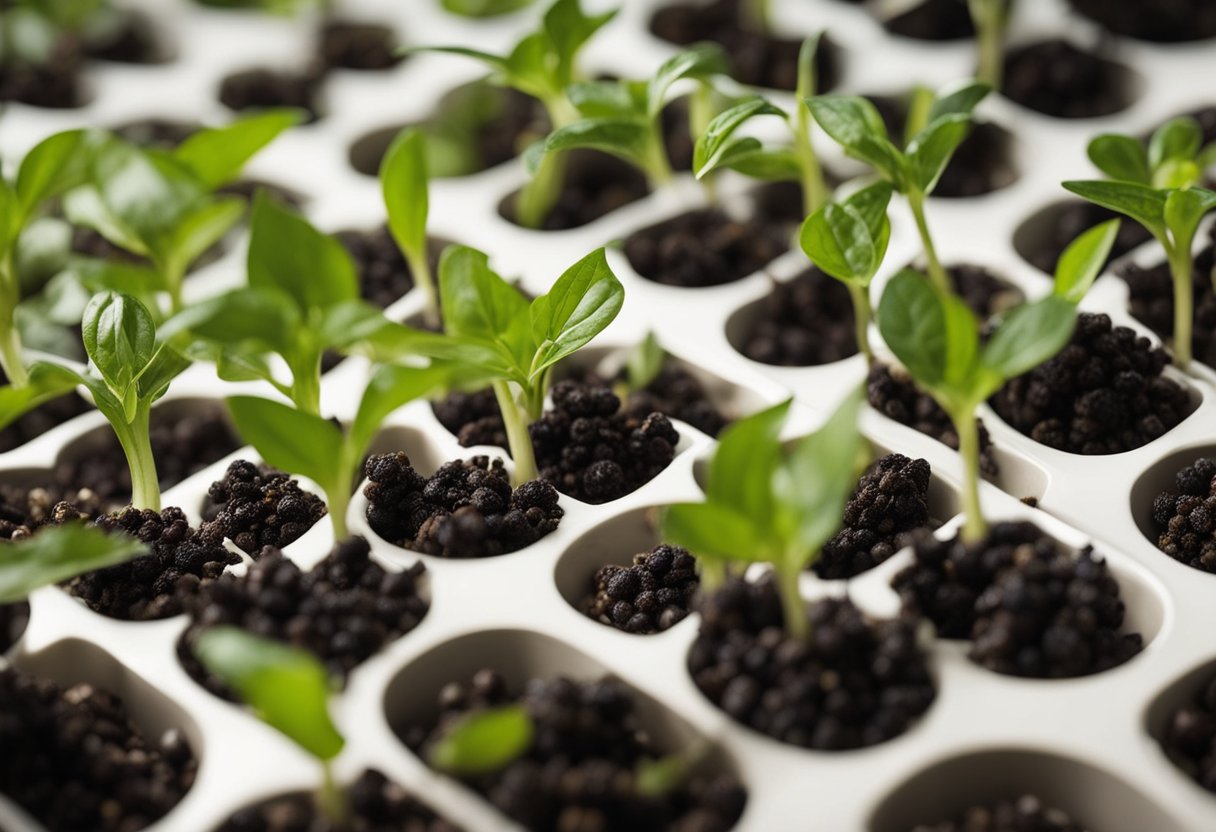
The timeline for growing peppers from seed can vary depending on the variety, growing conditions, and care provided.
Generally, most pepper seeds germinate within 5-10 days, but they require a long growing season of about 60 to 90 days before reaching harvest time. Some pepper varieties may take even longer, so it is important for gardeners to be patient and provide the necessary care throughout the process.
In order to successfully grow peppers from seed, gardeners should ensure that the seeds are provided with the proper environment for germination, including sufficient warmth, moisture, and air circulation.
As the seedlings develop, they should be potted up and gradually hardened off before being transplanted outdoors. By following these steps and providing consistent care, gardeners can cultivate a bountiful harvest of homegrown peppers.
Understanding the types of peppers
When growing peppers from seed, it’s essential to have a clear understanding of the different types of peppers. Knowing the various categories of peppers and specific pepper varieties can help you choose the right pepper seeds and times for planting, harvesting and enjoying the fruits of your labor.
Related: How Long Does It Take to Grow Apples: A Comprehensive Timeline
Categories of peppers
There are two main categories of peppers: hot peppers and sweet peppers.
Hot Peppers: These include a wide range of peppers that contain capsaicin, the compound responsible for their heat. The heat level varies from mildly spicy to extremely fiery, and it’s measured using the Scoville scale.
Sweet Peppers: These peppers don’t contain capsaicin or have only trace amounts, resulting in a mild, sweet flavor. Sweet peppers come in various shapes, sizes, and colors, making them a versatile addition to any garden.
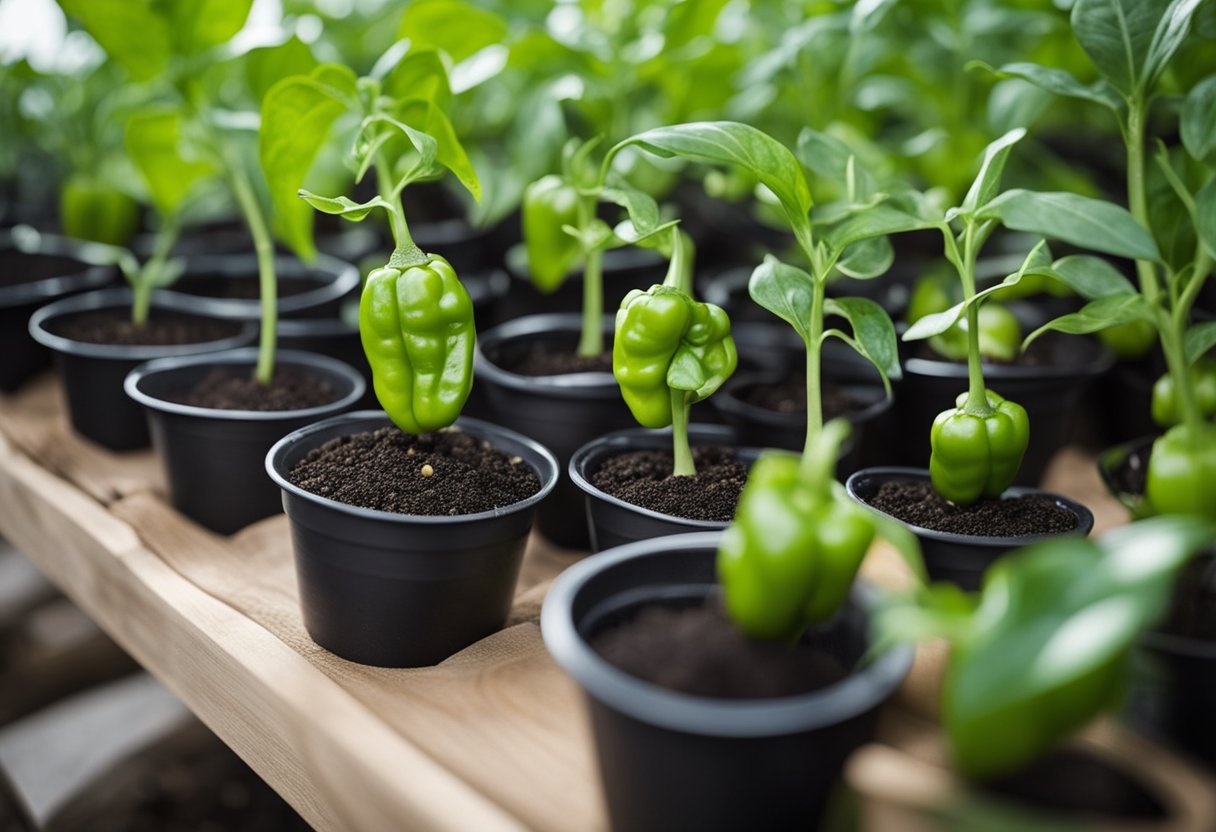
Specific pepper varieties
Within the broader categories of hot and sweet peppers, there are numerous specific pepper varieties. Some popular options include:
- Bell Peppers: A common sweet pepper variety, bell peppers take about 90-120 days to grow from seed. They are large, blocky, and come in various colors, including green, red, yellow, and orange.
- Banana Peppers: Also known as sweet banana peppers, these mild, sweet peppers are typically yellow and slightly curved, resembling a banana.
- Gypsy Peppers: Another sweet pepper variety, gypsies have thin walls and a tapered shape, with a mild flavor.
- Jalapeño Peppers: A popular hot pepper, jalapeños have a moderate level of heat and take around 65 days to grow from seed. They are often used in salsas and a variety of spicy dishes.
- Serrano Peppers: Similar to jalapeños, serranos have a slightly higher heat level and are often used in Mexican cuisine.
- Cayenne Peppers: Known for their long, slender shape, cayenne peppers are moderately hot and often used as a spice, either fresh or dried.
- Poblano Peppers: These mildly hot peppers have a thick-walled, heart-shaped fruit, and are commonly used in dishes like chiles rellenos.
- Shishito Peppers: A Japanese pepper variety with a wrinkled appearance, shishitos are usually mild, but occasionally can be slightly spicy.
- Anaheim Peppers: These mild chili peppers are large and often used for roasting or stuffing.
- Hatch Peppers: Hailing from New Mexico, hatch peppers are prized for their unique flavor and moderate heat level.
- Ghost Peppers: Among the world’s hottest peppers, ghost peppers should be grown and handled with caution due to their extreme heat.
- Carolina Reaper: Currently holding the title of the world’s hottest pepper, the Carolina Reaper is recommended for experienced growers, as its heat levels can be intense and potentially dangerous.
Understanding the types of peppers available and their specific characteristics can help you choose the right pepper seeds for your garden, leading to successful growth and a bountiful harvest.
Related: How Long Does It Take Lemons to Grow: A Comprehensive Guide
Proper preparation of your seeds and soil
Choosing and handling pepper seeds
When growing peppers from seed, it’s essential to select high-quality pepper seeds to ensure a successful yield. Choose seeds from reputable suppliers and store them in a cool, dry place until you’re ready to plant.

To handle the pepper seeds properly, gently pick them from the seed packet to avoid damaging them. Then, place the seeds on a clean surface, being careful not to lose any during the process.
Preparing the soil for optimal growth
To create a nurturing environment for your pepper seeds, start by choosing the right potting medium. A well-draining and sterile potting mix is ideal to promote healthy seedling growth.
You can either purchase a commercial potting mix or create your own using a combination of peat moss, compost, and perlite, ensuring that the mix is free of any pathogens or pests. Here is an example of a simple potting mix recipe:
- 50% peat moss
- 25% compost
- 25% perlite
Before filling your seed trays or peat pellets with the potting mix, be sure to moisten them. This helps to distribute moisture evenly throughout the mix and prevents excess water from accumulating. To do this, simply mix water into your potting medium until it feels damp, not wet.
Seed trays or peat pellets should provide ample drainage, as excess water can lead to seed rot and other diseases. Make sure your chosen containers have drainage holes at the bottom.
Once the potting mix is moistened, fill your seed trays or peat pellets evenly with the mix, gently compressing the soil to reduce air pockets. Next, create holes where the pepper seeds will be planted, typically no deeper than 0.25 inches.
Place one pepper seed into each hole, then gently cover the seeds with soil. Ensure that the seeds make contact with the soil but do not compact the soil around them.
Lastly, to promote germination, maintain consistent soil temperatures between 70-85°F (21-29°C) and keep the soil consistently moist but not overly wet. Proper soil temperature and moisture levels are crucial to successful pepper seed germination and growth.
Cultivation process
Starting peppers indoors
To grow peppers from seed, it’s best to start them indoors in a controlled environment. Most pepper seeds germinate within 5-10 days. Choose an appropriate container for your seeds, preferably with drainage holes to prevent overwatering.
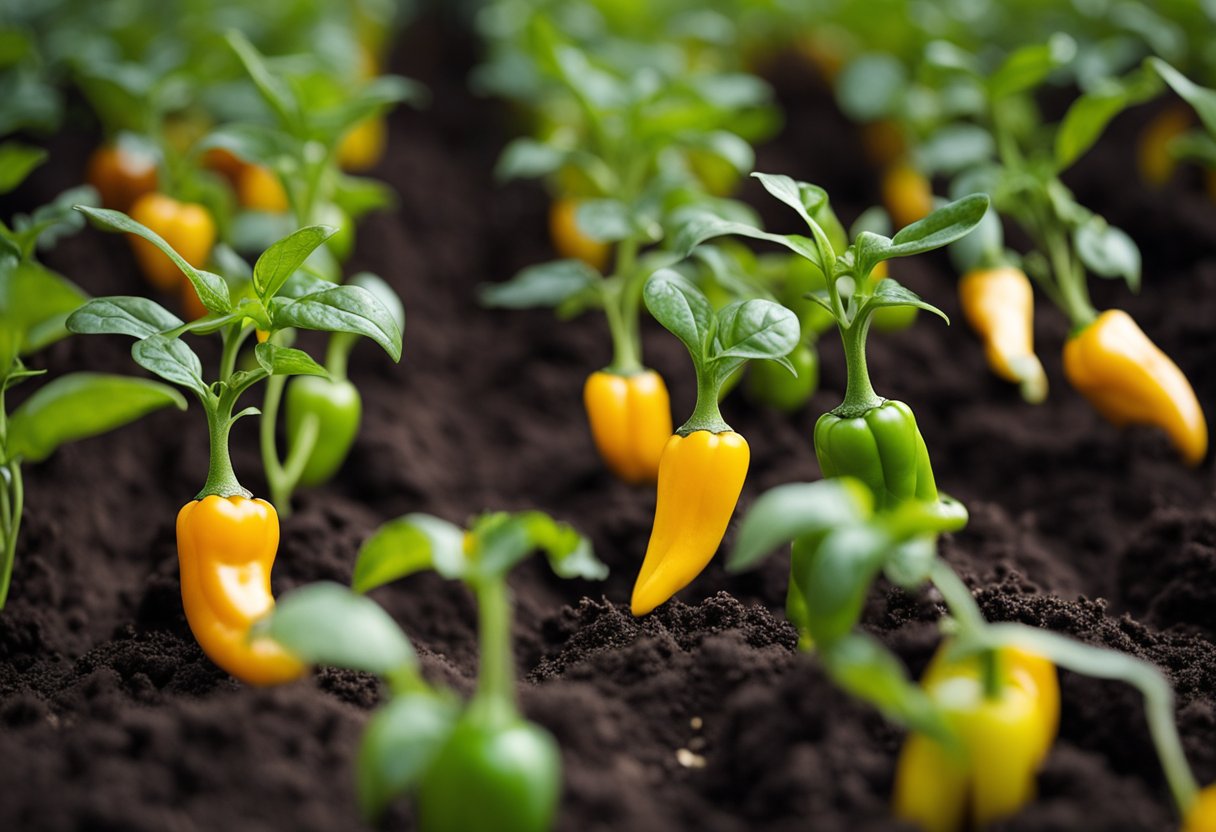
Fill the container with a high-quality seed-starting mix, and plant the seeds at the recommended depth according to the seed package instructions. Place the container in a warm, bright area to promote germination and seedling growth. Once the sprouts emerge and develop their first set of true leaves, they’re ready for the next stage.
Transitioning to the garden
Before transplanting your pepper seedlings outdoors, they need to acclimate to their new environment. This process, known as hardening off, involves gradually exposing the seedlings to outdoor conditions over a week or two.
Start by placing the seedlings in a sheltered spot outdoors for a few hours each day, slowly increasing the exposure time and sunlight intensity. Once the plants have adapted, they can be transplanted into the garden, making sure to space them according to the seed package recommendations. Choose a location with well-draining soil and full sun exposure.
Maintaining your pepper plants
Proper care is essential for growing healthy and productive pepper plants. Consistent watering is crucial, as inconsistent moisture can lead to issues such as blossom end rot or stunted growth.
However, avoid overwatering and ensure the soil drains well to prevent root rot. Use a balanced fertilizer to provide adequate nutrients, and apply it according to the package instructions. As the pepper plants grow, they may require support, such as stakes or cages, to prevent branches from breaking under the weight of maturing fruits.
Harvesting peppers
The time it takes for peppers to mature varies depending on the variety, with some taking as long as 100-150 days to fully ripen. Green peppers can typically be harvested earlier, while they are still unripe.
To harvest ripe red bell peppers or other colored varieties, wait until the fruit reaches its full color. Gently remove the peppers from the plant with a sharp knife or pruning shears, being careful not to damage the plant or remaining fruits.
Important factors in growth
Temperature requirements
Pepper plants thrive in warm temperatures. The ideal temperature range for germination is between 70-90°F (21-32°C). A seedling heat mat can be used to maintain consistent warmth during germination.
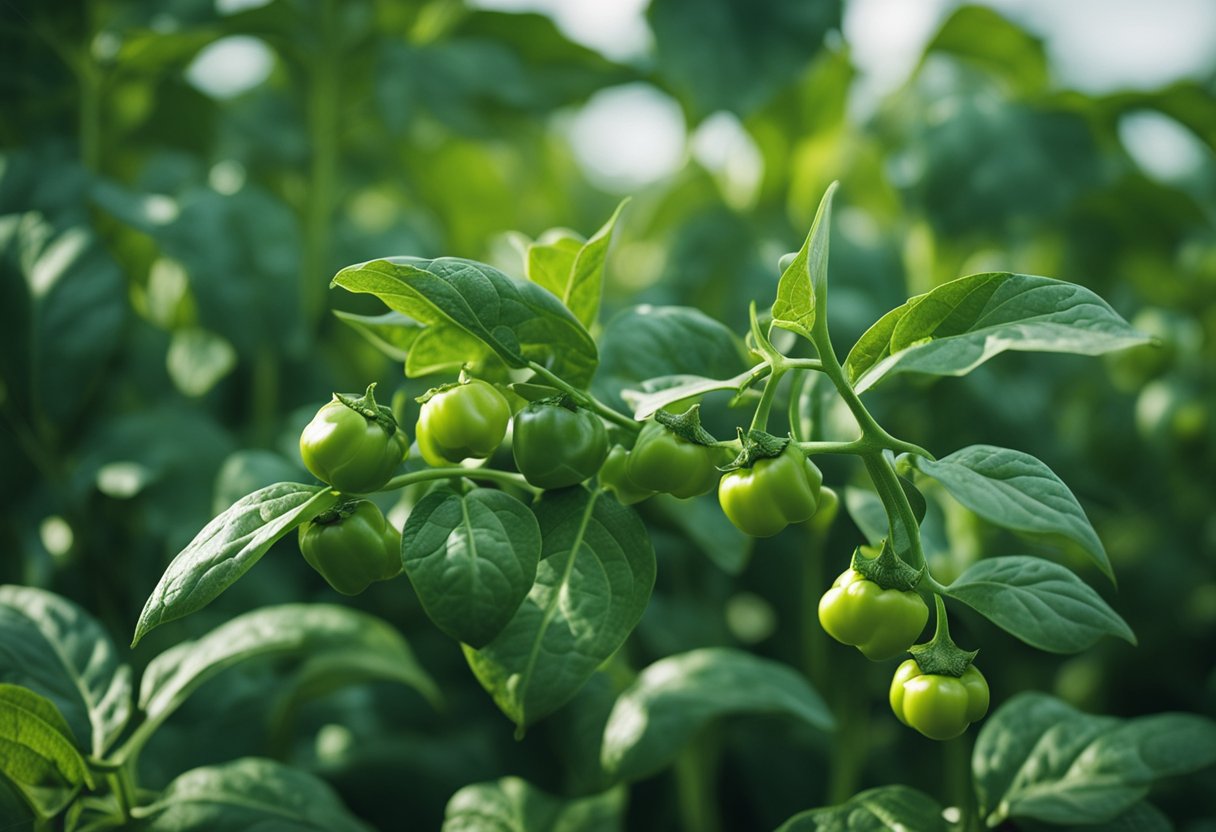
After germination, maintaining a temperature of about 65-75°F (18-24°C) during daytime and 55-65°F (13-18°C) during nighttime will promote healthy growth.
Light for pepper plants
Light plays an essential role in pepper plant growth. Seedlings require 14-16 hours of sunlight or artificial grow light per day for optimal growth.
Positioning the seedlings near a south-facing window or under a grow light will provide the necessary light exposure. Make sure to keep the grow light about 2-3 inches (5-8 cm) above the seedlings to prevent legginess.
Watering and fertilizing your peppers
Proper watering and fertilizing are crucial for pepper plant growth. Keep the soil evenly moist but not waterlogged during germination.
Overwatering may cause seedlings to rot, while underwatering may hinder germination. After germination, allow the soil to dry slightly between waterings.
Fertilize your peppers with a balanced, all-purpose fertilizer or a fertilizer specifically designed for peppers during transplanting. Then, continue to fertilize every 3-4 weeks, following the package instructions for the appropriate dosage.
Hardening off peppers before transplanting
Before transplanting pepper seedlings outdoors, it is essential to harden them off gradually.
Start by exposing seedlings to outdoor conditions for a few hours each day, gradually increasing the time they spend outside over a week or two. This acclimatization prevents shock from sudden changes in temperature and light, allowing plants to transition smoothly from an indoor to an outdoor environment.
Growth stages of pepper plants
Seed germination
The growth process for pepper plants begins with seed germination. Most pepper seeds germinate within 5-10 days.
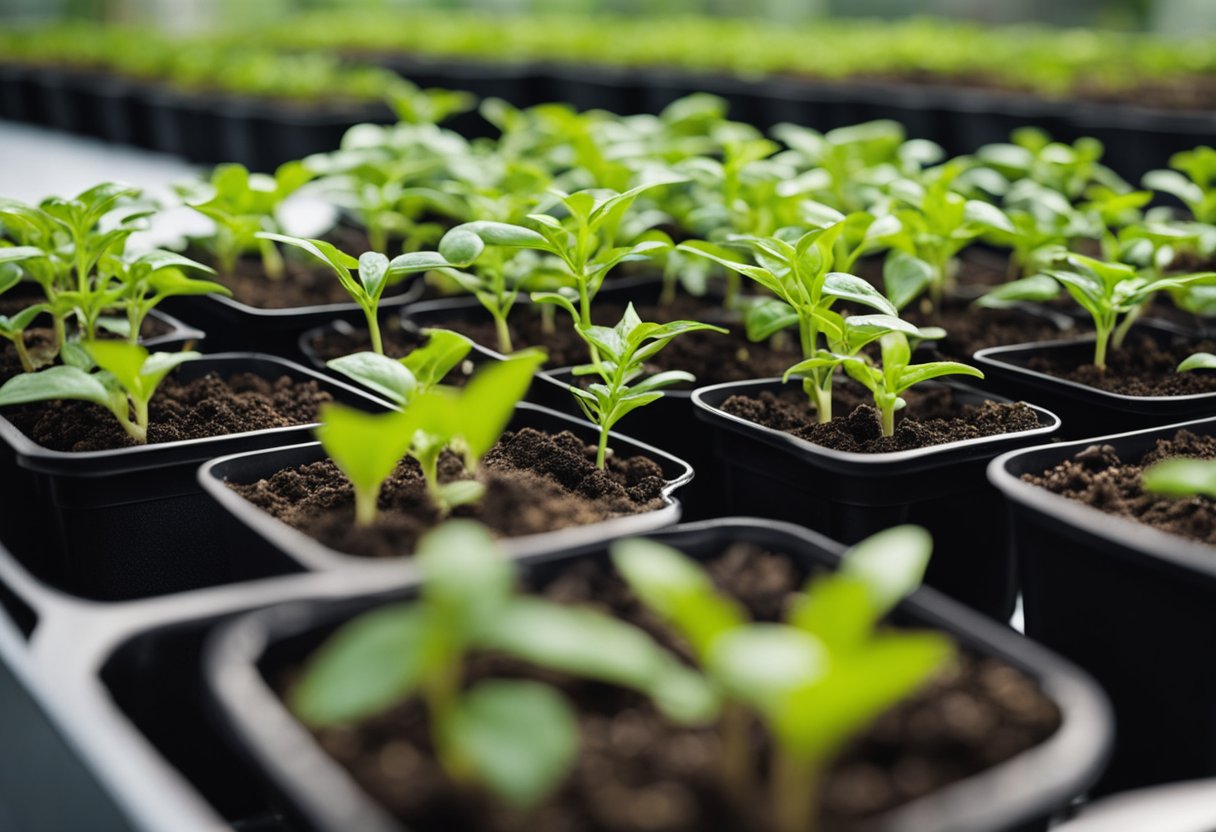
During this time, seeds absorb water and begin to sprout as the first root and shoot emerge. Proper moisture levels, warmth, and good soil quality are essential factors for successful germination.
Seedling stage
After germination, pepper plants enter the seedling stage, which typically lasts for about 2-4 weeks. Pepper seedlings grow quite slowly and are small and delicate, requiring proper care practices.
During this period, they need lots of light, up to 16 hours per day to facilitate healthy growth. As seedlings mature, their roots and stem structures develop, ultimately supporting future fruit production.
Flowering and fruit formation
Once pepper plants reach 4-8 weeks of growth, they enter the flowering stage. At this point, plants are usually transplanted outdoors, where they continue to grow and produce flowers.
The flowers are pollinated, either by insects or through self-pollination, leading to the formation of fruits. During the fruit formation stage, pepper fruits start small and gradually increase in size as they develop.
Ripening stage
The ripening stage, lasting 2-4 months, is the final phase of the pepper plant growth cycle. In this stage, the fruits change color and texture, indicating that they are becoming ripe.
The color change varies depending on pepper variety – some might go from green to red, while others might change to yellow or orange. It is essential to monitor the ripening process closely, as the taste and texture of the fruit are significantly impacted during this stage. When fruits are fully ripe, they can be harvested and used for culinary purposes or seed collection.
Throughout all these growth stages of pepper plants, it is essential to provide consistent care, including proper watering, fertilization, and pest management to ensure a healthy and bountiful harvest.
Problem control measures
Common pepper plant diseases
Pepper plants are susceptible to a variety of diseases that can hinder growth and harvest. Some common diseases include blight, bacterial leaf spot, and mosaic virus. To combat these diseases, implement the following measures:
- Ensure proper air circulation by spacing plants adequately.
- Remove and dispose of infected leaves to prevent the spread of disease.
- Use disease-resistant varieties of pepper seeds when planting.
- Avoid overwatering and water at the base of the plant rather than on the leaves.

Pollination issues and control measures
Peppers are self-pollinating, meaning they generally don’t require insects or other external factors to aid in pollination. However, some varieties may experience pollination issues, especially in extremely hot or cold temperatures. To promote successful pollination:
- Plant flowers nearby to attract pollinators like bees and butterflies.
- Manually pollinate by using a small paintbrush or cotton swab to transfer pollen from one flower to another within the same plant.
- Protect plants from extreme temperatures by providing shade or moving potted plants indoors during extreme weather conditions.
Following these control measures will help to address common problems and ensure a healthier, more bountiful pepper harvest.
Specialized pepper growing techniques
Growing peppers in containers
Growing peppers in containers is an excellent option for those with limited space or who prefer the flexibility to move their plants around. Choose a container that has sufficient drainage holes and is at least 12 inches wide and deep. Fill the container with a high-quality potting mix, ensuring it is slightly acidic to neutral (pH 6.3-7.0) for optimal pepper growth.
Plant the pepper seeds about 1/4 inch deep and maintain a consistent temperature between 70-85°F to enhance germination. Most pepper seeds will germinate within 5-10 days, and proper care will lead to harvesting ripe peppers around 60-90 days.

Water the plants regularly to keep the soil consistently moist but avoid overwatering, which can lead to root rot. Additionally, provide adequate air circulation and sunlight, as peppers need at least 6 to 8 hours of sun per day.
When growing peppers in containers, it’s vital to support the plants with stakes or cages as they grow to prevent the stems from breaking under the weight of the fruit.
Growing peppers in greenhouses
A greenhouse provides an excellent environment for growing peppers from seed due to the controlled temperature and humidity. Greenhouses enable a longer growing season and protect the plants from harsh weather conditions.
To grow peppers in a greenhouse, first, prepare the soil by amending it with organic matter such as compost or aged manure. Ensure the soil has a slightly acidic to neutral pH level (6.3-7.0) for optimal growth. Plant the seeds at a depth of 1/4 inch and maintain a consistent temperature between 70-85°F for successful germination.
Once the seedlings emerge, thin them out to provide enough space for each plant to grow and receive adequate sunlight. Peppers should be spaced around 18-24 inches apart in rows that are 24-36 inches apart.
Maintain proper air circulation within the greenhouse, as stagnant air can lead to the development of various diseases. Water the plants consistently, ensuring the soil remains moist but not overly saturated.
With the favorable conditions provided by a greenhouse, peppers can usually be harvested in about 60-90 days after planting the seeds, depending on the variety. Remember to provide support for the plants with stakes or cages to prevent breakage due to the weight of the fruit.
